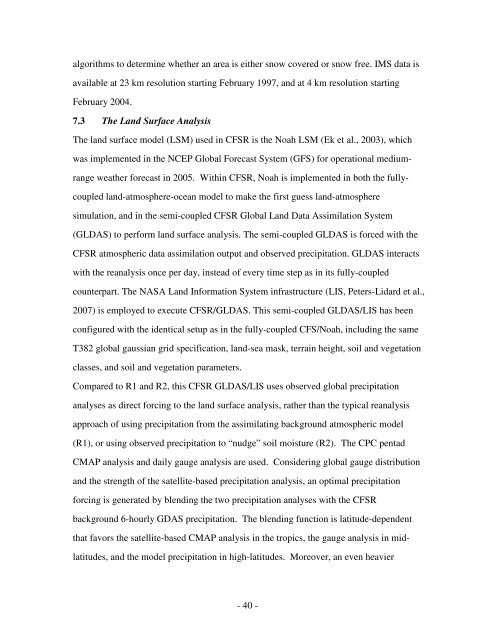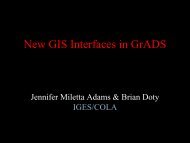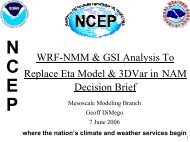The NCEP Climate Forecast System Reanalysis - NOAA National ...
The NCEP Climate Forecast System Reanalysis - NOAA National ...
The NCEP Climate Forecast System Reanalysis - NOAA National ...
You also want an ePaper? Increase the reach of your titles
YUMPU automatically turns print PDFs into web optimized ePapers that Google loves.
algorithms to determine whether an area is either snow covered or snow free. IMS data isavailable at 23 km resolution starting February 1997, and at 4 km resolution startingFebruary 2004.7.3 <strong>The</strong> Land Surface Analysis<strong>The</strong> land surface model (LSM) used in CFSR is the Noah LSM (Ek et al., 2003), whichwas implemented in the <strong>NCEP</strong> Global <strong>Forecast</strong> <strong>System</strong> (GFS) for operational mediumrangeweather forecast in 2005. Within CFSR, Noah is implemented in both the fullycoupledland-atmosphere-ocean model to make the first guess land-atmospheresimulation, and in the semi-coupled CFSR Global Land Data Assimilation <strong>System</strong>(GLDAS) to perform land surface analysis. <strong>The</strong> semi-coupled GLDAS is forced with theCFSR atmospheric data assimilation output and observed precipitation. GLDAS interactswith the reanalysis once per day, instead of every time step as in its fully-coupledcounterpart. <strong>The</strong> NASA Land Information <strong>System</strong> infrastructure (LIS, Peters-Lidard et al.,2007) is employed to execute CFSR/GLDAS. This semi-coupled GLDAS/LIS has beenconfigured with the identical setup as in the fully-coupled CFS/Noah, including the sameT382 global gaussian grid specification, land-sea mask, terrain height, soil and vegetationclasses, and soil and vegetation parameters.Compared to R1 and R2, this CFSR GLDAS/LIS uses observed global precipitationanalyses as direct forcing to the land surface analysis, rather than the typical reanalysisapproach of using precipitation from the assimilating background atmospheric model(R1), or using observed precipitation to “nudge” soil moisture (R2). <strong>The</strong> CPC pentadCMAP analysis and daily gauge analysis are used. Considering global gauge distributionand the strength of the satellite-based precipitation analysis, an optimal precipitationforcing is generated by blending the two precipitation analyses with the CFSRbackground 6-hourly GDAS precipitation. <strong>The</strong> blending function is latitude-dependentthat favors the satellite-based CMAP analysis in the tropics, the gauge analysis in midlatitudes,and the model precipitation in high-latitudes. Moreover, an even heavier- 40 -





